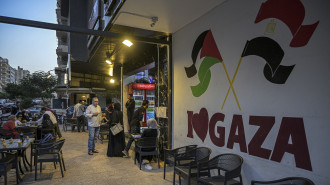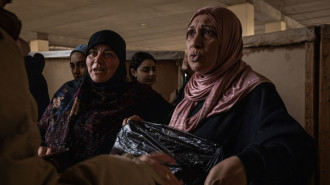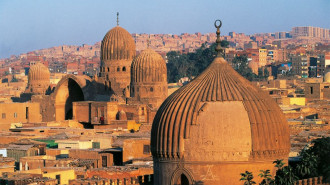
From Sudan to Lebanon: How artist Ali Cherri depicts ‘invisible violence’ in the Arab world

The American author and activist bell hooks once wrote that “to be in the margin is to be part of the whole but outside the main body.”
While a position of marginality is usually considered one of disadvantage, as it isn’t in the epicentre of institutional power, artists and activists have found countless ways of producing knowledge and change from the fringes.
Observing the centre from the outside can – in fact – often help bring certain truths to light; truths that might not seem so clear to someone from the inside.
"What I'm interested in is how we observe these major moments of unrest and revolution, and how they are being observed from the margins"
This is a theory often found in feminist, postcolonial, or Marxist texts, and one that the renowned Lebanese artist Ali Cherri had in mind when producing a trilogy of films about “geographies of violence” in the Arab world.
Through this work, he wanted to try and depict the invisible wounds caused by the state that many in the region experience.
The final work in this thematic trilogy is Cherri’s first feature film, called The Dam. After premiering to rapturous applause at the Cannes Film Festival last May in the Directors’ Fortnight category, the film is currently on a tour of around 20 film festivals around the world and is due for international release in 2023, notably in January in France (dates for other countries are yet to be announced).
The film follows Maher, a quiet Sudanese bricklayer who works on the banks of the Nile, near the Merowe Dam.
Every evening, he wanders off into the desert to build a mysterious construction made of mud. At the same time, the Sudanese Revolution of 2019 is unravelling, and protests bursting in the streets of Khartoum. Maher follows it calmly from the radio or TV during the day, while his mystical creation takes on surreal dimensions at night.
“What I'm interested in is how we observe these major moments of unrest and revolution, and how they are being observed from the margins,” Ali Cherri told The New Arab.
“What happens when we look at these things not from the centre, but when we go far? [I’m interested in] how these things are lived by people who feel not part of the major events. For me, they become the main role and they help clarify an understanding of what's happening.”
The Dam is as poetic as it is political. There is little dialogue in the film, but there is never a dull moment. The striking wide-angle shots in the desert and in the Nile composed by the cinematographer Bassem Fayad are accompanied by the cool magnetic presence of Maher El Khair, who is a real-life bricklayer in Sudan and whom Cherri met while researching his project on the Merowe Dam in northern Sudan.
Funded by China, Saudi Arabia and other Gulf countries, the Merlowe Dam is one of the most controversial energy projects in the world. Built between 2003 and 2009, it is the largest contemporary hydropower project in Africa and the most destructive in the world.
It has been widely criticised because it displaced more than 50,000 people from the fertile Nile Valley due to the significant decrease of water flowing downstream. For those who stayed, thousands of their homes were flooded by the rising waters of the reservoir, while many local protesters were killed by the Sudanese armed militia.
In the film, the heavy geopolitical context of both the Marlowe Dam and the Sudanese revolution form the backdrop of Maher’s story and his allegorical creation, but again the portrait of this character on the margins allows us to subtly understand the wider political events that build up the film’s narrative arc.
"Ali Cherri always navigated towards art, but being born in Beirut in 1976, at the start of the Lebanese Civil War, politics became inherent in his work and existence, as were questions of survival and trauma"
Cherri had not planned filming during the Sudanese revolution. Initially, he wanted to make a film around the Marlowe Dam to use water “as a lens to look at local populations and the geopolitics of a country.” When he met Maher, he became determined in anchoring the film in his reality and that of the other bricklayers – merging documentary with fiction.
“When we were shooting, the workers were only listening to the radio, without ever commenting. For them, life continued. This is what happens in the film as well,” he said.
The final film of his “telluric trilogy” (related to the Earth), The Dam follows The Disquiet and The Digger, two short films that explored the relationship between labour, violence and trauma in the MENA region, the first set in Lebanon and the second in the UAE.
“This whole project is really a political project, of trying to understand questions related to the region of unrest, violence, complicated histories, and possibilities of future.”
Cherri is more known as a visual artist than a filmmaker, and it shows in his meditative and theoretical approach. In cinema, he is interested in making “sensorial” films, like those of the Taiwanese filmmaker Tsai Ming-Liang, who Cherri praised for his talent in cinematically capturing silence and routine.
In the contemporary art world, Cherri was an Artist in Residence at the National Gallery in London in 2021, and this year he won a Silver Lion Award at the Venice Biennale for his multidisciplinary work intersecting telluric materials with mythology.
Ali Cherri always navigated towards art, but being born in Beirut in 1976, at the start of the Lebanese Civil War, politics became inherent in his work and existence, as were questions of survival and trauma, like many Lebanese artists.
“I was interested in this idea of surviving. What does it mean to survive the war? Do we ever survive? I wasn’t wounded in the war, I didn’t die. And there’s this stupid idea that you should survive because nothing happened to you. You’re fine and you have to continue.”
|
Looking at Lebanon today, Cherri reflected that these questions continue to persist, except now the trauma and survivor’s guilt come from the Beirut blast on August 4, 2020.
“Post-August 4 explosion, people that were not hurt, they have to continue… but we’re all broken. Looking at this idea of how violence can become invisible and how it's inscribed in our bodies and everything around us, Beirut today is the best example of this.
“Most people will tell you what they were doing right before and right after, but everyone will tell you that they cannot describe what happened during it [the blast]. The moments of the eruption of violence are always outside of even language itself – outside of representation.”
Ali Cherri concluded that striving to represent this “invisible violence” – this trauma that he and many others in the region carry with them, this burdensome weight that is often unspoken but is never silent – would possibly be an impossible task to take on as an artist.
“This idea of representing this invisible violence is always a failed project, one that we can only try and approach, but we will never be able to do,” he said.
But then, with a slight sliver of hope, he affirmed: “the role of art is to try to represent these moments which are unspeakable.”
Alexander Durie is a Multimedia Journalist for The New Arab. His stories focus on social movements, migration issues, and the arts & culture of the SWANA region. He has contributed to The Guardian, Al Jazeera English, The Economist, The Independent, and more.
Follow him on Twitter: @alexander_durie
![Palestinians mourned the victims of an Israeli strike on Deir al-Balah [Getty]](/sites/default/files/styles/image_684x385/public/2024-11/GettyImages-2182362043.jpg?h=199d8c1f&itok=xSHZFbmc)


![The law could be enforced against teachers without prior notice [Getty]](/sites/default/files/styles/image_684x385/public/2178740715.jpeg?h=a5f2f23a&itok=hnqrCS4x)
 Follow the Middle East's top stories in English at The New Arab on Google News
Follow the Middle East's top stories in English at The New Arab on Google News


